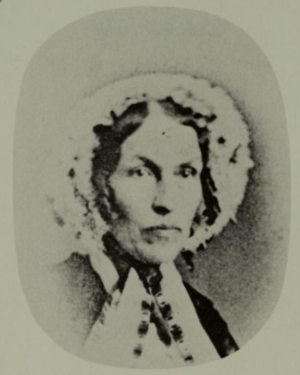Hannah Ropes facts for kids
Quick facts for kids
Hannah Ropes
|
|
|---|---|
 |
|
| Born | June 13, 1809 New Gloucester |
| Died | January 20, 1863 Georgetown |
| Occupation | Nurse, abolitionist, writer |
| Parent(s) | |
| Family | Theophilus Chandler, Peleg Chandler |
Hannah Anderson Ropes was an American nurse, a writer, and a strong supporter of ending slavery. She lived from June 13, 1809 to January 20, 1863. She is known for her work as a nurse during the American Civil War and for writing about her experiences.
Early Life and Family
Hannah Anderson Chandler was born on June 13, 1809 in New Gloucester, Maine. She was the seventh of ten children. Her father, Peleg Chandler, was a lawyer. Her mother was Esther Parsons Chandler.
Hannah's brothers, Theophilus and Peleg, also became lawyers and politicians. We don't know much about her schooling. However, because her family was well-off, she likely received a good education.
In February 1834, Hannah married William Henry Ropes. He was a teacher who also farmed to earn enough money. They had four children, but only two lived to be adults: Edward Elson Ropes (born 1837) and Alice Shephard Ropes (born 1841).
In 1837, Hannah joined a religious group called the Boston Society of the New Jerusalem. She became a follower of Swedenborgianism. This was a different choice from the usual churches in New England. Hannah liked being an individual and making her own choices.
Between 1847 and 1855, Hannah and William's marriage ended. William Ropes moved to Florida for good. Hannah stayed in New England to raise their two children.
Fighting for Freedom in Kansas
In the 1850s, Hannah Ropes became a passionate abolitionist. This meant she strongly believed that slavery should be ended. At this time, the Kansas Territory was a place where people who supported slavery and those who opposed it often clashed. This period was known as "Bleeding Kansas" because of the violence.
Many people from New England, including Hannah's son Edward, moved to Kansas in 1855. They wanted to claim land and make sure Kansas became a free state, meaning it would not allow slavery. Hannah and her daughter Alice joined Edward in Lawrence, Kansas in September 1855. While there, Hannah helped by nursing sick settlers.
Life in Kansas was dangerous. Pro-slavery groups often attacked abolitionist settlers. In November, Hannah wrote to Senator Charles Sumner about the violence. She said that no home was safe and that men were being attacked without reason. She also wrote to her mother that she kept "loaded pistols and a bowie-knife" by her bed. She also had "three Sharp’s rifles, loaded, standing in the room."
Because of the violence and poor living conditions, Hannah sent Alice back to Massachusetts. Soon after, Hannah also decided to leave Kansas. She returned to Massachusetts in April 1856. This meant she missed the sacking of Lawrence in May, when pro-slavery forces attacked the town.
Hannah quickly turned her many letters into a book. It was published later that year as Six Months in Kansas: By a Lady. She continued to work for the abolitionist cause. In 1859, she published a novel called Cranston House, which was inspired by her son's experience settling land.
Civil War Nurse
In 1860, Hannah's nephew gave her a copy of Florence Nightingale's famous book, Notes on Nursing: What it is and What it is Not. This book, along with her own nursing experience in Kansas, inspired Hannah. She wanted to help the Union during the American Civil War. Her own son had joined the Union Army.
In 1862, Hannah volunteered to be a nurse in a military hospital. She was made a matron, which meant she supervised other nurses, at the Union Hotel Hospital in Georgetown. This hospital was once a fancy hotel but had become known for its terrible conditions.
Military nurses were overseen by Dorothea Dix, a very strict supervisor. Even though nurses were low in the chain of command, Hannah used her social and political connections to improve things. For example, a hospital worker was stealing supplies meant for wounded soldiers. The chief surgeon, Dr. A. M. Clark, did nothing, even after many complaints. Hannah went directly to US Secretary of War Edwin Stanton. Stanton had both the worker and Dr. Clark arrested.
Later that year, Louisa May Alcott came to the Union Hotel Hospital as a volunteer nurse. Alcott admired Hannah Ropes and praised her in Hospital Sketches. This was a book Alcott wrote about her time as a nurse.
In late December, several nurses, including Hannah and Alcott, became sick. Doctors first thought they had pneumonia and gave them mercury, which didn't help. They were later diagnosed with typhoid fever. Alcott was sent home to get better. Sadly, Hannah Ropes died on January 20, 1863. Senator Sumner arranged her funeral.
Hannah had planned to write another book about her hospital experiences. Her diary and letters were later collected and published in 1980 as Civil War Nurse: The Diary and Letters of Hannah Ropes.

